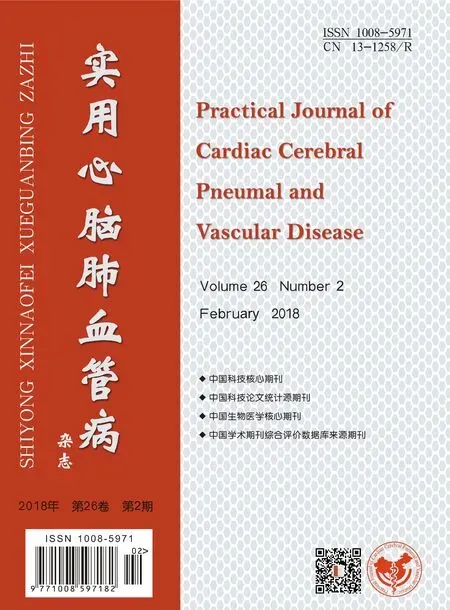结节性硬化症的遗传学研究进展
王玉婷,桑道乾
结节性硬化症(TSC)是一种常染色体显性遗传病,是多个神经系统受累的神经皮肤综合征,其发病率为1/10 000~1/6 000[1]。1880 年 法 国 神 经 病 学 家 Désiré-Magloire Bourneville对TSC进行了系统描述,TSC是一种良性非侵袭性肿瘤样病变(被称为错构瘤),可累及脑、肾、皮肤、心、肺、肝、眼睛等[2],主要临床特征为面部皮脂腺瘤、癫痫发作和智力减退。2012年,国际结节性硬化症共识会议上提出心脏与皮肤病变通常是发现TSC的第一线索[2]。近年来,临床在TSC基因突变筛查、疾病诊断及治疗等方面取得一定进展[3]。本文综述了TSC的遗传学研究进展,以期指导临床更好地掌握其发病机制,进而为临床诊治提供参考。
1 TSC1和TSC2基因
TSC有两个缺陷基因(TSC1和TSC2),分别位于9q34和16p13.3。目前,已发现TSC1和TSC2基因存在8种突变类型,300多种突变方式。TSC1和TSC2基因中任何一个发生突变引起的临床表现均是可变的,即使有相同的基因突变也可以显示出多种临床表现。研究表明,65%~75%的TSC患者是自发突变[4]。也有研究表明,存在TSC1或TSC2基因致病性突变即可诊断为TSC[2]。因此,明确TSC患者基因诊断,并了解其发病机制具有重要意义。
1.1 TSC1基因突变 TSC1基因包含23个外显子,其中第1个和第2个外显子为非编码区,第3个至第23个外显子为编码区,从第222个核苷酸起开始转录,其基因产物为错构瘤蛋白。TSC1基因突变类型多为无义突变、移码突变及剪接突变,而错义突变及基因大片段缺失或重排较少见[5-6]。SLEGTENHORST等[7]研究表明,TSC1基因突变大多数位于外显子15和17,且家系患者和散发患者的基因突变率无明显差异。GAN等[8]研究表明,TSC1第403~787位氨基酸残基有一个粘着斑激酶家族互作蛋白(FIP200)结合区域,FIP200可通过与TSC1第403~787位氨基酸区域相互作用而调控TSC1-TSC2复合体功能,上调S6激酶的磷酸化水平,调节细胞大小。FIP200作为一种新的TSC1互作蛋白,能负性调节TSC1功能。MURPHY等[9]报道了1例由TSC1缺失导致散发淋巴管平滑肌瘤患者的病例资料,但并未排除其存在嵌合体突变的可能。既往研究表明,行为变异型额颞叶痴呆(bvFTD)是由TSC1基因新移码突变引起TSC1/错构瘤蛋白转录提前终止所致,TSC1/错构瘤蛋白是哺乳动物雷帕霉素靶蛋白(mTOR)上游抑制剂,能调节细胞生长和蛋白质降解[10-11]。TSC1基因突变的TSC患者临床表现轻于TSC2基因突变者,可能与TSC1基因“二次打击”发生率低于TSC2基因有关[12-14]。1971年,克努森提出“二次打击”假说[15],其是由正常等位基因大片段缺失引发,可通过筛选杂合性丢失(LOH)进行评估。研究表明,错构瘤或皮质结节发生机制可能与“二次打击”有关[16-17]。
1.2 TSC2基因突变 TSC2基因包含42个外显子,其中41个外显子通过5.4 kb的mRNA编码马铃薯球蛋白,其基因产物为结节蛋白[18-19]。研究表明,结节蛋白与鸟苷三磷酸酶激活蛋白(GAP)高度同源[20-21]。TSC2基因突变形式多样,其中剪接突变、无义突变、移码突变及错义突变较多,而大片段基因缺失或重排较少。研究表明,与TSC1基因相比,TSC2基因突变发生率较高[4]。NELLIST等[22]研究表明,TSC2异亮氨酸残基820缺失、TSC2的C244R、L1511H和Y598H氨基酸替代会导致TSC的发生;而TSC2的R1771C、T993M、S132C、F143L、A196T替代是罕见的基因多态性,不能抑制TSC1-TSC2功能,不会引发TSC。QIN等[23]对46个TSC皮质结节样本的TSC1、TSC2和KRAS基因进行高通量测序,发现TSC1、TSC2和KRAS基因“二次打击”广泛分布于同一侧大脑半球,且发生率达10%。MONTEIRO等[24]对35例TSC患者进行研究,结果发现TSC2基因突变者占58.3%。JONES等[12]研究表明,TSC2基因突变的TSC患者临床表现较严重、并发症较多、智力减退发生率较高。
1.3 TSC1和TSC2基因突变检出情况 TSC患者基因突变检出率为69%~89%。AU等[25]研究表明,325例TSC患者基因突变检出率为72%,其中TSC1突变占20%,TSC2突变占80%;另外,TSC1 15号外显子和TSC2 16号外显子突变发生率较高。SANCAK等[26]研究表明,276例TSC患者基因突变检出率为85%,其中TSC2基因突变检出率∶TSC1基因突变检出率为3.4∶1.0。DABORA等[27]研究表明,224例TSC患者基因突变检出率约为83%,其中无义突变占29%,缺失突变占27%,错义突变占19%,剪接位点突变占17%,插入突变占8%。也有研究发现,TSC患者中TSC1基因突变占比较低,基因突变形式及位点各异,且无热区分布[27-29]。分析其原因可能为:(1)基因突变位点位于未能检测到的内含子或其他非编码区,如启动子区等;(2)存在其他基因突变位点(如TSC3、TSC4等);(3)可能为嵌合体突变;(4)目前检测技术无法检测出复杂的基因大范围缺失或重排;(5)检测技术灵敏度不高或发生漏检等。
2 TSC发病机制
TSC1基因编码的错构瘤蛋白是一种130 kDa跨越1 164个氨基酸的蛋白质;TSC2基因编码的马铃薯球蛋白是一种200 kDa跨越1 807个氨基酸的蛋白质[30]。错构瘤蛋白和马铃薯球蛋白在细胞内形成异二聚体,通过TSC-Rheb-TORS6K1/4EBP1途径调节细胞增殖,参与细胞黏附等[31-33]。TSC1或TSC2基因突变会导致mTOR信号级联活性增高,引起细胞生化异常(包括转录、翻译、细胞周期调控、代谢水平等)。mTOR信号级联〔磷脂酰肌醇3-激酶(PI3Ks)/蛋白激酶B(Akt)/mTOR通路〕在正常细胞生长、增殖和存活中发挥着重要作用[11]。mTOR可形成mTORC1和mTORC2两种多蛋白复合体,主要通过相互作用物、底物选择性、对西罗莫司及其类似物依维莫司的敏感性不同进行区分[34-35]。mTORC1下游效应包括基因转录、蛋白翻译、细胞增殖和存活、血管新生;mTORC2可调节细胞骨架信号通路[35]。近年研究发现,HMGA2通路可参与TSC患者肿瘤形成[36]。
3 治疗方法
西罗莫司与依维莫司通过与FK506结合蛋白12(FKBP12)结合形成复合物而抑制mTORC1分泌[37]。依维莫司已被美国食品药品监督管理局(FDA)批准用于治疗不能进行手术的室管膜下巨细胞星形细胞瘤(SEGAs)或肾血管平滑肌脂肪瘤(AML)患者,也适用于治疗存在皮肤表现、癫痫、肺淋巴管肌瘤病的TSC患者[38]。BISSLER等[39]研究表明,依维莫司可有效缩小TSC患者肿瘤体积。HINTON等[40]研究表明,西罗莫司可有效缩小TSC患者血管平滑肌脂肪瘤体积,并改善患者肺功能,但停药12个月后肿瘤体积和肺功能接近治疗前。
4 小结
近年来,随着生物技术飞速发展,TSC的研究取得了突破性进展,为TSC的基因诊断和治疗打下了坚实基础。目前,以TSC1及TSC2基因突变为基础的病理变异和自然病程变化机制尚不完全明确,且新的检测技术有待开发,相信随着研究的不断深入,人类终将实现TSC的基因治疗。
[1]SANTOS L,BRCIC I,UNTERWEGER G,et al.Hamartomatous polyposis in tuberous sclerosis complex:Case report and review of the literature[J].Pathol Res Pract,2015,211(12):1025-1029.DOI:10.1016/j.prp.2015.09.016.
[2]KRUEGER D A,NORTHRUP H,International Tuberous Sclerosis Complex Consensus Group.Tuberous sclerosis complex surveillance and management:recommendations of the 2012 International Tuberous Sclerosis Complex Consensus Conference[J].Pediatr Neurol,2013,49(4):255-265.DOI:10.1016/j.pediatrneurol.2013.08.002.
[3]PALAVRA F,ROBALO C,REIS F.Recent Advances and Challenges of mTOR Inhibitors Use in the Treatment of Patients with Tuberous Sclerosis Complex[J].Oxid Med Cell Longev,2017:9820181.DOI:10.1155/2017/9820181.
[4]DIMARIO F J Jr,SAHIN M,EBRAHIMI-FAKHARI D.Tuberous sclerosis complex[J].Pediatr Clin North Am,2015,62(3):633-648.DOI:10.1016/j.pcl.2015.03.005.
[5]NELLIST M,VAN DEN HEUVEL D,SCHLUEP D,et al.Missense mutations to the TSC1 gene cause tuberous sclerosis complex[J].Eur J Hum Genet,2009,17(3):319-328.DOI:10.1038/ejhg.2008.170.
[6]HOOGEVEEN-WESTERVELD M,EKONG R,POVEY S,et al.Functional assessment of TSC1 missense variants identified in individuals with tuberous sclerosis complex[J].Hum Mutat,2012,33(3):476-479.DOI:10.1002/humu.22007.
[7]SLEGTENHORST M V,VERHOEF S,TEMPELAARS A,et al.Mutational spectrum of the TSC1 gene in a cohort of 225 tuberous sclerosis complex patients:no evidence for genotype-phenotype correlation[J].J Med Genet,1999,36:285-289.
[8]GAN B,MELKOUMIAN Z K,WU X,et al.Identification of FIP200 interaction with the TSC1-TSC2 complex and its role in regulation of cell size control[J].J Cell Biol,2005,170(3):379-389.DOI:10.1083/jcb.200411106.
[9]MURPHY S J,TERRA S B,HARRIS F R,et al.Genomic rearrangements in sporadic lymphangioleiomyomatosis:an evolving genetic story[J].Mod Pathol,2017,30(9):1223-1233.DOI:10.1038/modpathol.2017.52.
[10]OLNEY N T,ALQUEZAR C,RAMOS E M,et al.Linking tuberous sclerosis complex,excessive mTOR signaling,and agerelated neurodegeneration:a new association between TSC1 mutation and frontotemporal dementia[J].Acta Neuropathol,2017,134(5):813-816.DOI:10.1007/s00401-017-1764-0.
[11]LAPLANTE M,SABATINI D M.mTOR signaling in growth control and disease[J].Cell,2012,149(2):274-293.DOI:10.1016/j.cell.2012.03.017.
[12]JONES A C,SHYAMSUNDAR M M,THOMAS M W,et al.Comprehensive mutation analysis of TSC1 and TSC2-and phenotypic correlations in 150 families with tuberous sclerosis[J].Am J Hum Genet,1999,64(5):1305-1315.DOI:10.1086/302381.
[13]TYBURCZY M E,WANG J A,LI S,et al.Sun exposure causes somatic second-hit mutations and angiofibroma development in tuberous sclerosis complex[J].Hum Mol Genet,2014,23(8):2023-2029.DOI:10.1093/hmg/ddt597.
[14]TYBURCZY M E,JOZWIAK S,MALINOWSKA I A,et al.A shower of second hit events as the cause of multifocal renal cell carcinoma in tuberous sclerosis complex[J].Hum Mol Genet,2015,24(7):1836-1842.DOI:10.1093/hmg/ddu597.
[15]KNUDSONAG A G Jr.Mutation and cancer:statistical study of retinoblastoma[J].Proc Nat Acad Sci USA,1971,68(4):820-823.
[16]HINO O,KOBAYASHI T.Mourning Dr. Alfred G. Knudson:the two-hit hypothesis,tumor suppressor genes,and the tuberous sclerosis complex[J].Cancer Sci,2017,108(1):5-11.DOI:10.1111/cas.13116.
[17]ROBENS B K,GROTE A,PITSCH J,et al.Minute amounts of hamartin wildtype rescue the emergence of tuber-like lesions in conditional Tsc1 ablated mice[J].Neurobiol Dis,2016,95:134-144.DOI:10.1016/j.nbd.2016.07.006.
[18]GIANNIKOU K,MALINOWSKA I A,PUGH T J,et al.Whole Exome Sequencing Identifies TSC1/TSC2 Biallelic Loss as the Primary and Sufficient Driver Event for Renal Angiomyolipoma Development[J].PLoS Genet,2016,12(8):e1006242.DOI:10.1371/journal.pgen.1006242.
[19]FUJITA A,ANDO K,KOBAYASHI E,et al.Detection of low-prevalence somatic TSC2 mutations in sporadic pulmonary lymphangioleiomyomatosis tissues by deep sequencing[J].Hum Genet,2016,135(1):61-68.DOI:10.1007/s00439-015-1611-0.
[20]CHAN J A,ZHANG H,ROBERTS P S,et al.Pathogenesis of tuberous sclerosis subependymal giant cell astrocytomas:biallelic inactivation of TSC1 or TSC2 leads to mTOR activation[J].J Neuropathol Exp Neurol,2004,63(12):1236-1242.
[21]KHARE L,STRIZHEVA G D,BAILEY J N,et al.A novel missense mutation in the GTPase activating protein homology region of TSC2 in two large families with tuberous sclerosis complex[J].Journal of Medical Genetics,2001,38:347-349.DOI:10.1136/jmg.38.5.347.
[22]NELLIST M,SANCAK O,GOEDBLOED M,et al.Functional characterisation of the TSC1-TSC2 complex to assess multiple TSC2 variants identified in single families affected by tuberous sclerosis complex[J].BMC Med Genet,2008,9:10.DOI:10.1186/1471-2350-9-10.
[23]QIN W,CHAN J A,VINTERS H V,et al.Analysis of TSC cortical tubers by deep sequencing of TSC1,TSC2 and KRAS demonstrates that small second-hit mutations in these genes are rare events[J].Brain Pathol,2010,20(6):1096-1105.DOI:10.1111/j.1750-3639.2010.00416.x.
[24]MONTEIRO T,GARRIDO C,PINA S,et al.Tuberous sclerosis:clinical characteristics and their relationship to genotype/phenotype[J].An Pediatr (Barc),2014,81(5):289-296.DOI:10.1016/j.anpedi.2014.03.022.
[25]AU K S,WILLIAMS A T,ROACH E S,et al.Genotype/phenotype correlation in 325 individuals referred for a diagnosis of tuberous sclerosis complex in the United States[J].Genet Med,2007,9(2):88-100.DOI:10.1097GIM.0b013e31803068c7.
[26]SANCAK O,NELLIST M,GOEDBLOED M,et al.Mutational analysis of the TSC1 and TSC2 genes in a diagnostic setting:genotype--phenotype correlations and comparison of diagnostic DNA techniques in Tuberous Sclerosis Complex[J].Eur J Hum Genet,2005,13(6):731-741.DOI:10.1038/sj.ejhg.5201402.
[27]DABORA S L,JOZWIAK S,FRANZ D N,et al.Mutational analysis in a cohort of 224 tuberous sclerosis patients indicates increased severity of TSC2,compared with TSC1,disease in multiple organs[J].The American Journal of Human Genetics,2001,68(1):64-80.DOI:10.1086/316951.
[28]张林妹,周渊峰,柴毅明,等.结节性硬化105例临床特征和基因型分析[J].中国循证儿科杂志,2016,11(3):219-222.DOI:10.3969/j.issn.1673-5501.2016.03.012.
[29]黄昌艳.结节性硬化症TSC1/TSC2基因突变的高通量测序快速诊断[J].细胞与分子免疫学杂志,2016,32(1):92-95.
[30]LESMA E,SIRCHIA S M,ANCONA S,et al.The methylation of the TSC2 promoter underlies the abnormal growth of TSC2 angiomyolipoma-derived smooth muscle cells[J].Am J Pathol,2009,174(6):2150-2159.DOI:10.2353/ajpath.2009.080799.
[31]HAN J M,SAHIN M.TSC1/TSC2 signaling in the CNS[J].FEBS Lett,2011,585(7):973-980.DOI:10.1016/j.febslet.2011.02.001.
[32]TOMASONI R,MONDINO A.The tuberous sclerosis complex:balancing proliferation and survival[J].Biochem Soc Trans,2011,39(2):466-471.DOI:10.1042/BST0390466.
[33]ORLOVA K A,CRINO P B.The tuberous sclerosis complex[J].Ann N Y Acad Sci,2010,1184:87-105.DOI:10.1111/j.1749-6632.2009.05117.x.
[34]MACKEIGAN J P,KRUEGER D A.Differentiating the mTOR inhibitors everolimus and sirolimus in the treatment of tuberous sclerosis complex[J].Neuro Oncol,2015,17(12):1550-1559.DOI:10.1093/neuonc/nov152.
[35]COSTA-MATTIOLI M,MONTEGGIA L M.mTOR complexes in neurodevelopmental and neuropsychiatric disorders[J].Nat Neurosci,2013,16(11):1537-1543.DOI:10.1038/nn.3546.
[36]D'ARMIENTO J,SHIOMI T,MARKS S,et al.Mesenchymal Tumorigenesis Driven by TSC2 Haploinsufficiency Requires HMGA2 and Is Independent of mTOR Pathway Activation[J].Cancer Res,2016,76(4):844-854.DOI:10.1158/0008-5472.CAN-15-1287.
[37]YANG H,RUDGE D G,KOOS J D,et al.mTOR kinase structure,mechanism and regulation[J].Nature,2013,97(7448):217-223.DOI:10.1038/nature12122.
[38]MOAVERO R,CONIGLIO A,GARACI F,et al.Is mTOR inhibition a systemic treatment for tuberous sclerosis?[J].Ital J Pediatr,2013,39:57.DOI:10.1186/1824-7288-39-57.
[39]BISSLER J J,MCCORMACK F X,YOUNG L R,et al.Sirolimus for angiomyolipoma in tuberous sclerosis complex or lymphangioleiomyomatosis[J].N Engl J Med,2008,358(2):140-151.DOI:10.1056/NEJMoa063564.
[40]HINTON R B,PRAKASH A,ROMP R L,et al.Cardiovascular manifestations of tuberous sclerosis complex and summary of the revised diagnostic criteria and surveillance and management recommendations from the International Tuberous Sclerosis Consensus Group[J].J Am Heart Assoc,2014,3(6):e001493.DOI:10.1161/JAHA.114.001493.

